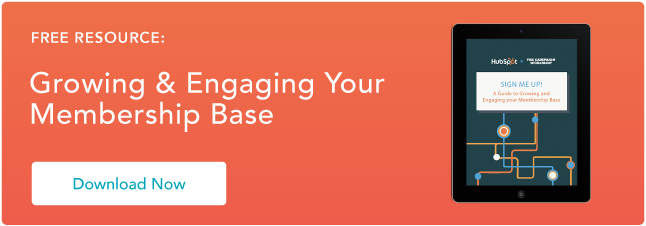
We understand: change is difficult in the nonprofit world.
Everything takes time, and many projects require approval from multiple levels of superiors. It may seem daunting to suggest a change of course. In the case of inbound marketing, though, the change is worth fighting for.
Here are seven talking points to convince your team that your organization needs to adopt inbound marketing. And, for a more in-depth look, check our our ebook, “A Crash Course on Inbound Marketing for Nonprofits.”
1) “It’s becoming easier and easier for people to avoid our calls and emails. Let’s create content that people will seek out themselves.”
Between caller ID and smart email filters, it’s increasingly difficult to reach your audiences. Plus, phone calls often disrupt people’s days. How can you reach the greatest number of people you want to be talking to?
Create great content.
Great content acts as a magnet for your website. Your constituents will come to you when they’re looking to get involved, and your donors will approach you when they’re ready to contribute. You won’t have to worry about reaching them at a time that’s convenient for them.
2) “We’ll produce a body of knowledge that shows off our expertise in an accessible way, becoming a trusted source of information in the process.”
Creating written content that drives traffic to your site requires you to frame your ideas, projects, and initiatives in a manner that the average citizen can understand. Showcasing your expertise and your ability to connect with donors, volunteers, or members is crucial to building a broad base of support.
When information is accessible to constituents, they’ll be far more trusting of your organization and its ability to allocate resources honestly. They’ll also become more informed on the challenges surrounding your cause.
3) “Creating this content will force us to think deeply about what our beneficiaries, volunteers, and donors actually want and need.”
In order to craft content that will drive website engagement, you first need to consider what your desired audience is looking for. In the process, you’ll break through surface to really understand their day-to-day goals and challenges as well as objections to your platform and initiatives.
Take the process of drafting a case study—one of the most compelling forms of content that serves to convince new donors and volunteers to join your cause. Putting together a case study requires you to go out and get to know the people you’re serving and their stories of struggle.
Research, writing, and repackaging your ideas in accessible formats like case studies are activities that will make your team more introspective. By keeping the focus on who you’re serving, you’ll inevitably serve their needs better.
4) “When budgets get tight, we’ll be prepared.”
You’re all too familiar with shoestring budgets, and if you’re in a managerial position, you understand the difficulty of deciding whether it’s worth it to spend a bit more on paid advertising int the hopes of bringing in more donations.
The success of most traditional marketing campaigns directly corresponds with the amount of resources (both human and financial) at one’s disposal. Think about it this way: when you purchase a print ad, online ad, or billboard, you’re really renting that rectangle of space.
Wouldn’t you rather build up an arsenal of material that you own?
When you own something, you have it forever and you can repurpose it as often as you’d like. Sounds like a compelling argument for creating content.
Inevitably, a recession will arrive, and it will be hard to commit to spending large sums on advertising. If you’re forced to cut staff, the output of phone banks and other forms of outreach will be lower.
Protect yourself against market downturns by proactively creating a wealth of resources that bring in the most relevant visitors possible and require little manpower for maintenance.
(Not to mention that writing is free!)
5) “Instead of making a one-way request for support, we’ll already have provided them with value at the moment when they see our CTAs.”
When people are attracted to your website for the content it contains, they’ll come in knowing that you have something to offer them: knowledge, a unique perspective, or inspiration. It won’t be a one-way request for support, funds, or volunteer hours—instead, it will be a genuine exchange of ideas, something that benefits both you and them.
6) “It opens the door to connecting with our community in a new way.”
A crucial part of any inbound strategy is social media amplification of content. It might seem counterintuitive to create a Facebook page or Twitter profile for an agency in sector that is traditionally a serious one, but if you’re looking to engage with the widest range of people possible, social media is the best way to amplify your impact.
You can’t ignore the pervasiveness of social media in our 21st-century lives. Social media is where many people get their news now since they check it so often. By staying off the platform, you’re bound to be sacrificing the chance to connect with a critical portion of your constituency.
At their core, social media platforms are mediums for engagement and conversation. They’re the perfect place to connect with people and share your message. If you can show that you understand digital trends and that you’re willing to share updates, engage with other industry players, and correspond with community members, you’ll seem far more accessible – and garner more support.
7) “We’ll be able to keep track of how we’ve engaged with different people much more easily since it’s tech-based.”
Perhaps one of the biggest benefits of inbound is the power it affords you in tracking how various people have interacted with your materials. Organizing your inbound efforts allows you to pinpoint exactly which methods are most effective at targeting certain demographics.
Similarly, tracking improves efficiency. Overtime, you’ll be able to see who responds well to your content and spend time reaching out to those people. Inbound gives you valuable insight into the workings of your audience’s minds, allowing you to avoid aimlessly sending out emails to and calling thousands of people.
Trying Out These Talking Points
These talking points are just some ideas to get you thinking about how to get buy-in for change at your organization. To help structure your conversation, take a look at our free kit on selling inbound to your board —in includes a customizable PPT presentation that your team will love, and more.
![]()







